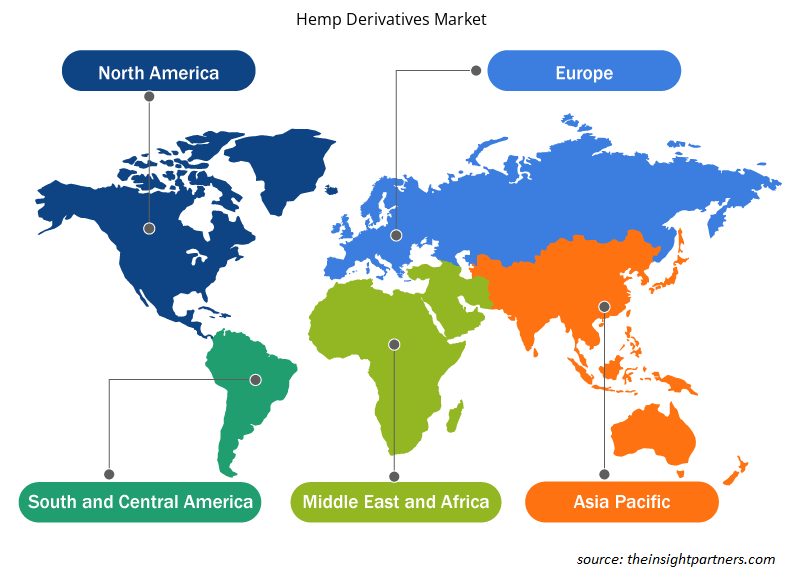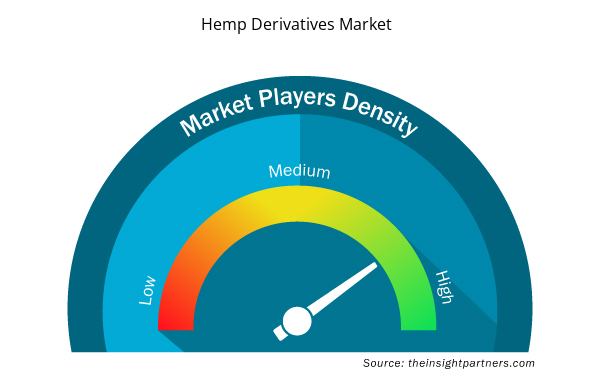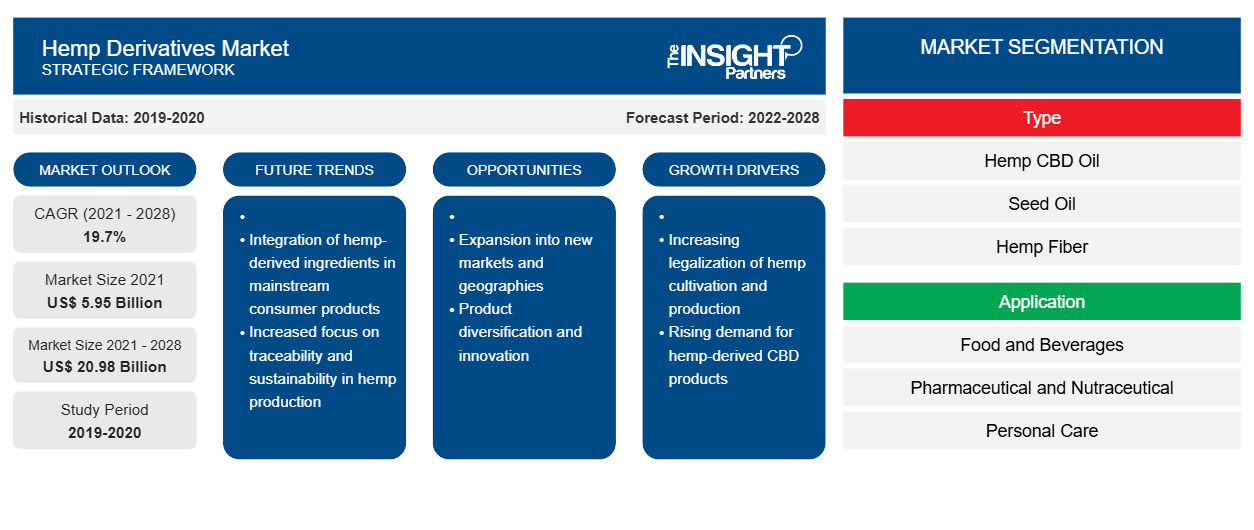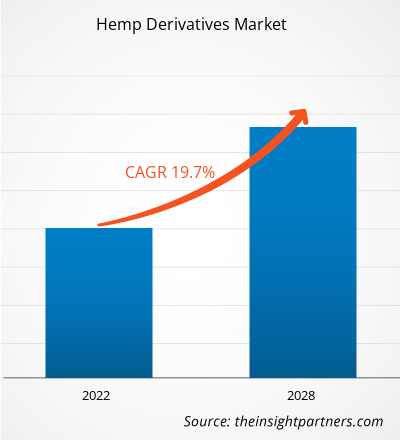Le marché des dérivés du chanvre a été évalué à 5 953,86 millions de dollars américains en 2021 et devrait atteindre 20 977,94 millions de dollars américains d'ici 2028 ; il devrait croître à un TCAC de 19,7 % de 2021 à 2028.
Le chanvre ou chanvre industriel est une variété de plantes de cannabis sativa, qui sont spécifiquement cultivées pour un usage industriel. Les dérivés du chanvre, tels que le CBD, l'huile de graines et les fibres, sont dérivés du chanvre et ont diverses applications dans plusieurs industries d'utilisation finale, telles que l'alimentation et les boissons, les produits pharmaceutiques, les soins personnels et l'alimentation animale.
En 2021, l'Asie-Pacifique représentait la plus grande part du marché mondial des dérivés du chanvre . La sensibilisation croissante aux bienfaits médicaux des dérivés du chanvre accroît leur utilisation dans la région. Parallèlement à cela, les dérivés du chanvre trouvent plusieurs applications dans l'industrie textile. En outre, le marché en plein essor des cosmétiques et des produits de soins personnels en Asie-Pacifique et la légalisation du chanvre industriel dans les compléments alimentaires devraient stimuler le marché de la région au cours de la période de prévision.
La pandémie de COVID-19 en cours a eu un impact relativement positif sur le marché des dérivés du chanvre. La pandémie a contribué à développer la sensibilisation et l’intérêt pour le secteur médical du chanvre. La crise a été une période désagréable et stressante pour la plupart de la population mondiale. Par conséquent, les gens du monde entier ont commencé à consommer des produits dérivés du chanvre pour traiter leur anxiété et leur stress. Plusieurs utilisateurs importants ont augmenté leur consommation. La consommation à utiliser pour un trouble du sommeil et la dépression est également hyperbolique. En raison de l’accent accru mis sur la santé et le bien-être pendant la pandémie, les recherches sur Google concernant les avantages pour la santé fournis par les dérivés du chanvre ont augmenté, ce qui accroît la sensibilisation à ces dérivés. Parallèlement, de nombreux pays ont été touchés par des déficits fiscaux au milieu de la pandémie. Les gouvernements des pays recherchent des sources de recettes fiscales. La source potentielle peut être la légalisation du chanvre et de ses dérivés, qui pourrait devenir progressivement attrayante. Une augmentation des ventes de chanvre et de ses dérivés par des vendeurs légaux peut fournir un gain potentiel de recettes fiscales.
Diverses activités de recherche ont également été menées pendant la pandémie de COVID-19, axées sur l’utilisation du chanvre et de ses dérivés pour le traitement de la COVID-19. Des chercheurs canadiens ont mené une étude pour vérifier si les extraits de Cannabis sativa peuvent aider à réduire les niveaux du récepteur de la cellule hôte auquel le virus SARS-CoV-2 s’accroche pour pénétrer dans le corps et se propager. Parallèlement à cela, STERO Biotech, une société basée en Israël, donne un aperçu de l’utilisation du cannabis et du CBD comme traitement potentiel de la COVID-19. Ainsi, diverses activités de recherche sur le chanvre et ses dérivés pour découvrir leur utilisation dans le traitement de la COVID-19 ont un impact positif sur le marché des dérivés du chanvre.
Personnalisez ce rapport en fonction de vos besoins
Vous bénéficierez d'une personnalisation gratuite de n'importe quel rapport, y compris de certaines parties de ce rapport, d'une analyse au niveau des pays, d'un pack de données Excel, ainsi que d'offres et de remises exceptionnelles pour les start-ups et les universités.
- Obtenez les principales tendances clés du marché de ce rapport.Cet échantillon GRATUIT comprendra une analyse de données, allant des tendances du marché aux estimations et prévisions.
Informations sur le marché
Applications croissantes des dérivés du chanvre dans diverses industries
Le chanvre est de plus en plus utilisé pour diverses applications dans différentes industries. Les graines de chanvre et le tourteau de chanvre sont utilisés comme source alternative de protéines alimentaires et fourragères dans l'industrie agroalimentaire. Parallèlement, l'huile obtenue lors du broyage des graines de chanvre est utilisée dans la fabrication de savons, de shampoings, de lotions, de cosmétiques et de gels de bain. L'huile obtenue à partir des graines de chanvre est riche en acides aminés, minéraux et vitamines, et elle est utilisée dans les compléments alimentaires ainsi que dans les produits médicinaux et thérapeutiques. Les fibres obtenues à partir du chanvre contiennent une grande quantité d'hémicellulose, ainsi qu'une grande capacité d'absorption, ce qui en fait une culture adaptée à l'industrie textile. Les tiges et les fibres de chanvre sont utilisées pour fabriquer des vêtements, du papier, des matériaux de construction, du plastique et des composites, entre autres. La fibre de chanvre est également utilisée dans la fabrication de matériaux isolants et de biocomposites en raison de sa résistance élevée, de sa biodégradabilité, de ses propriétés thermodynamiques et de sa légèreté. Les fibres de chanvre sont utilisées dans l'industrie de la construction pour la fabrication de matériaux de construction tels que les panneaux de fibres, le stuc et le mortier, les blocs de ciment, les revêtements, les matériaux acoustiques et les enveloppes de tuyaux. Les composites, qui sont utilisés dans la fabrication de produits à base de pétrole, sont également fabriqués à partir de chanvre. Les graines de chanvre sont riches en nutriments et en protéines et peuvent être utilisées comme substitut au soja. En raison de leur teneur en protéines, les graines de chanvre sont utilisées dans la production de produits majeurs à base de soja, notamment le tofu, le beurre, le fromage, les hamburgers, la crème glacée et le lait. Ainsi, l'augmentation des applications des dérivés du chanvre dans diverses industries a entraîné une augmentation de la demande de dérivés du chanvre, stimulant ainsi le marché des dérivés du chanvre.
Informations sur les types
En fonction du type, le marché des dérivés du chanvre est segmenté en huile de CBD de chanvre, huile de graines, fibre de chanvre et autres. Le segment des fibres de chanvre détenait la plus grande part du marché en 2021. Le chanvre est une plante à fibres libériennes comme le jute, le kénaf et le lin. Ces fibres sont désormais utilisées comme renforts dans les matériaux composites en raison de leur biodégradabilité et de leur densité inférieure à celle des fibres artificielles. La fibre de chanvre conduit la chaleur, résiste à la moisissure, se teint bien, bloque les rayons ultraviolets et possède des propriétés antibactériennes naturelles.
Quelques-uns des principaux acteurs du marché opérant sur le marché des dérivés du chanvre sontColorado Hemp Works, Inc ; Dun Agro Hemp Group ; Ecofiber ; Hempflax Group BV ; Hempoland Sp. Z OO ; Konoplex, Mh Medical Hemp Gmbh ; Plains Industrial Hemp Processing Ltd ; South Hemp ; et BAFA Neu GmbH. Les principaux acteurs du marché adoptent des stratégies telles que les fusions et acquisitions et les lancements de produits pour étendre leur présence géographique et leur base de consommateurs.
Rapports en vedette
- Tendances progressistes dans l'industrie des dérivés du chanvre pour aider les acteurs à développer des stratégies efficaces à long terme
- Stratégies de croissance commerciale adoptées par les entreprises pour assurer leur croissance sur les marchés développés et en développement
- Analyse quantitative du marché mondial des dérivés du chanvre de 2019 à 2028
- Estimation de la demande en dérivés du chanvre dans diverses industries
- Analyse de Porter pour illustrer l'efficacité des acheteurs et des fournisseurs opérant dans l'industrie pour prédire la croissance du marché
- Développements récents pour comprendre le scénario concurrentiel du marché et la demande de dérivés du chanvre
- Tendances et perspectives du marché associées aux facteurs qui stimulent et freinent la croissance du marché des dérivés du chanvre
- Compréhension des stratégies qui sous-tendent l'intérêt commercial à l'égard de la croissance du marché mondial des dérivés du chanvre, aidant au processus de prise de décision
- Taille du marché des dérivés du chanvre à différents nœuds du marché
- Aperçu détaillé et segmentation du marché mondial des dérivés du chanvre ainsi que de sa dynamique industrielle
- Taille du marché des dérivés du chanvre dans diverses régions avec des opportunités de croissance prometteuses
Aperçu régional du marché des dérivés du chanvre
Les tendances régionales et les facteurs influençant le marché des dérivés du chanvre tout au long de la période de prévision ont été expliqués en détail par les analystes d’Insight Partners. Cette section traite également des segments et de la géographie du marché des dérivés du chanvre en Amérique du Nord, en Europe, en Asie-Pacifique, au Moyen-Orient et en Afrique, ainsi qu’en Amérique du Sud et en Amérique centrale.

- Obtenez les données régionales spécifiques au marché des dérivés du chanvre
Portée du rapport sur le marché des dérivés du chanvre
| Attribut de rapport | Détails |
|---|---|
| Taille du marché en 2021 | 5,95 milliards de dollars américains |
| Taille du marché d'ici 2028 | 20,98 milliards de dollars américains |
| Taux de croissance annuel moyen mondial (2021-2028) | 19,7% |
| Données historiques | 2019-2020 |
| Période de prévision | 2022-2028 |
| Segments couverts | Par type
|
| Régions et pays couverts | Amérique du Nord
|
| Leaders du marché et profils d'entreprises clés |
|
Densité des acteurs du marché des dérivés du chanvre : comprendre son impact sur la dynamique commerciale
Le marché des dérivés du chanvre connaît une croissance rapide, tirée par la demande croissante des utilisateurs finaux en raison de facteurs tels que l'évolution des préférences des consommateurs, les avancées technologiques et une plus grande sensibilisation aux avantages du produit. À mesure que la demande augmente, les entreprises élargissent leurs offres, innovent pour répondre aux besoins des consommateurs et capitalisent sur les tendances émergentes, ce qui alimente davantage la croissance du marché.
La densité des acteurs du marché fait référence à la répartition des entreprises ou des sociétés opérant sur un marché ou un secteur particulier. Elle indique le nombre de concurrents (acteurs du marché) présents sur un marché donné par rapport à sa taille ou à sa valeur marchande totale.
Les principales entreprises opérant sur le marché des dérivés du chanvre sont :
- Colorado Hemp Works, Inc.
- Groupe Dun Agro Hemp
- Écofibre
- Groupe HempFlax BV
- HemPoland Sp. z oo
Avis de non-responsabilité : les sociétés répertoriées ci-dessus ne sont pas classées dans un ordre particulier.

- Obtenez un aperçu des principaux acteurs du marché des dérivés du chanvre
Marché des dérivés du chanvre, par type
- Huile de CBD de chanvre
- Huile de graines
- Fibre de chanvre
- Autres
Marché des dérivés du chanvre, par application
- Alimentation et boissons
- Produits pharmaceutiques et nutraceutiques
- Soins personnels
- Textiles
- Autres
Profils d'entreprise
- Colorado Hemp Works, Inc
- Groupe Dun Agro Hemp
- Écofibre
- Groupe Hempflax BV
- Hempoland Sp. Z OO
- Konoplex
- Mh Medical Hemp Gmbh
- Traitement industriel du chanvre des plaines Ltée
- Chanvre du Sud
- BAFA Neu GmbH
- Analyse historique (2 ans), année de base, prévision (7 ans) avec TCAC
- Analyse PEST et SWO
- Taille du marché Valeur / Volume - Mondial, Régional, Pays
- Industrie et paysage concurrentiel
- Ensemble de données Excel


- Artwork Management Software Market
- Intraoperative Neuromonitoring Market
- HVAC Sensors Market
- Cosmetic Bioactive Ingredients Market
- Europe Industrial Chillers Market
- Aesthetic Medical Devices Market
- Dry Eye Products Market
- Procedure Trays Market
- Hydrogen Storage Alloys Market
- Biopharmaceutical Contract Manufacturing Market

Report Coverage
Revenue forecast, Company Analysis, Industry landscape, Growth factors, and Trends

Segment Covered
This text is related
to segments covered.

Regional Scope
North America, Europe, Asia Pacific, Middle East & Africa, South & Central America

Country Scope
This text is related
to country scope.
Questions fréquemment posées
Europe is estimated to register the fastest CAGR in the market over the forecast period. The increase in the demand for personal care and cosmetic products in Europe has led to the growth of the cosmetic industry. According to Cosmetic Europe, the Personal Care Association, the European personal care and cosmetic market is the largest in the world. According to Eurostat, the cosmetic and personal care industry in Europe is estimated to be at least US$ 34.2 billion in added value to the European economy annually.
Among the four segments of type, hemp fiber segment has led the hemp derivatives market in 2021. Hemp is a bast fiber plant which is similar Jute, Kenaf, Flax among others. Hemp fiber is considered as one of the strong members of bast natural fibers family and is derived from the hemp plant under the species of Cannabis. These fibers are now being used as reinforcements in composite materials which is due to their biodegradability and low density compared with artificial fibers. The hemp fiber has various properties such as it conducts heat, resists mildew, dyes well, blocks ultraviolet light and has natural anti-bacterial properties.
Personal care segment is the fastest growing segment in the global hemp derivatives market during the forecasted period. Hemp derivatives has various applications in the personal care and cosmetic industry which includes usage in the manufacturing of soaps, cream, oil, lip balm, shampoos among others. Derivative such as hemp seed are rich in alpha-linolenic acid (omega-3) and linoleic acid (omega-6) along with hemp oil’s high and balanced fatty acids content which makes them an ideal ingredient for beauty care products. The hemp oil is used in cosmetic as they can penetrate through layers of the skin to promote cell growth. The hemp seeds are also used to repair and moisturize the dry and damaged skin along with supporting the health of hairs and nails. Hemp oil is an effective moisturizer which can provide the skin with a barrier for pollutants and can smooth the muscle aches.
Cannabidiol (CBD) is non-psychoactive and has various properties which led to an increased application CBD hemp oil across various industries. CBD hemp oil has various nutrients and minerals which are used for treating topical skin problems such as acne. Acne is a highly prevalent skin problem for which treatment options are in high demand. Moreover, CBD hemp oil is available in a variety of forms to make consumption easier, including edible options. CBD hemp oil is used for promoting health as it helps in body functioning with the changing environment. Thus, various application of hemp CBD oil in different industries has led to a growing demand of hemp derivative in this segment.
The major players operating in the hemp derivative market are Colorado Hemp Works, Inc, Dun Agro Hemp Group, Ecofiber, Hempflax Group B.V., Hempoland Sp. Z O.O., Konoplex, Mh Medical Hemp Gmbh, Plains Industrial Hemp Processing Ltd, South Hemp, and BAFA Neu GmbH.
In 2021, Asia Pacific held the largest revenue share of the global hemp derivatives market. The increase in awareness about the medical benefits of hemp derivates has led to an increase in the utilization of hemp derivatives in Asia Pacific. Along with this, hemp derivatives find several applications in the textile industry. This dominance can be attributed to the extensive production and consumption of hemp fibers in the textile and paper industry. Furthermore, the booming market for cosmetics and personal care products in the Asia Pacific region and legalization of industrial hemp in food supplements is estimated to drive the hemp derivatives market in the region. In recent years, there has been an increase in consciousness regarding personal appearance among individuals in Asia Pacific, which has led to an increase in demand for cosmetic products, resulting in the growth of the cosmetic market in the region. The desire for a presentable personal image among Asian consumers has led to an increased awareness of personal hygiene habits.
Trends and growth analysis reports related to Consumer Goods : READ MORE..
The List of Companies - Hemp Derivatives Market
- Colorado Hemp Works, INC
- Dun Agro Hemp Group
- Ecofibre
- HempFlax Group B.V.
- HemPoland Sp. z o.o.
- Konoplex
- MH medical hemp GmbH
- Plains Industrial Hemp Processing Ltd.
- South Hemp
- BAFA Neu GmbH
The Insight Partners performs research in 4 major stages: Data Collection & Secondary Research, Primary Research, Data Analysis and Data Triangulation & Final Review.
- Data Collection and Secondary Research:
As a market research and consulting firm operating from a decade, we have published and advised several client across the globe. First step for any study will start with an assessment of currently available data and insights from existing reports. Further, historical and current market information is collected from Investor Presentations, Annual Reports, SEC Filings, etc., and other information related to company’s performance and market positioning are gathered from Paid Databases (Factiva, Hoovers, and Reuters) and various other publications available in public domain.
Several associations trade associates, technical forums, institutes, societies and organization are accessed to gain technical as well as market related insights through their publications such as research papers, blogs and press releases related to the studies are referred to get cues about the market. Further, white papers, journals, magazines, and other news articles published in last 3 years are scrutinized and analyzed to understand the current market trends.
- Primary Research:
The primarily interview analysis comprise of data obtained from industry participants interview and answers to survey questions gathered by in-house primary team.
For primary research, interviews are conducted with industry experts/CEOs/Marketing Managers/VPs/Subject Matter Experts from both demand and supply side to get a 360-degree view of the market. The primary team conducts several interviews based on the complexity of the markets to understand the various market trends and dynamics which makes research more credible and precise.
A typical research interview fulfils the following functions:
- Provides first-hand information on the market size, market trends, growth trends, competitive landscape, and outlook
- Validates and strengthens in-house secondary research findings
- Develops the analysis team’s expertise and market understanding
Primary research involves email interactions and telephone interviews for each market, category, segment, and sub-segment across geographies. The participants who typically take part in such a process include, but are not limited to:
- Industry participants: VPs, business development managers, market intelligence managers and national sales managers
- Outside experts: Valuation experts, research analysts and key opinion leaders specializing in the electronics and semiconductor industry.
Below is the breakup of our primary respondents by company, designation, and region:

Once we receive the confirmation from primary research sources or primary respondents, we finalize the base year market estimation and forecast the data as per the macroeconomic and microeconomic factors assessed during data collection.
- Data Analysis:
Once data is validated through both secondary as well as primary respondents, we finalize the market estimations by hypothesis formulation and factor analysis at regional and country level.
- Macro-Economic Factor Analysis:
We analyse macroeconomic indicators such the gross domestic product (GDP), increase in the demand for goods and services across industries, technological advancement, regional economic growth, governmental policies, the influence of COVID-19, PEST analysis, and other aspects. This analysis aids in setting benchmarks for various nations/regions and approximating market splits. Additionally, the general trend of the aforementioned components aid in determining the market's development possibilities.
- Country Level Data:
Various factors that are especially aligned to the country are taken into account to determine the market size for a certain area and country, including the presence of vendors, such as headquarters and offices, the country's GDP, demand patterns, and industry growth. To comprehend the market dynamics for the nation, a number of growth variables, inhibitors, application areas, and current market trends are researched. The aforementioned elements aid in determining the country's overall market's growth potential.
- Company Profile:
The “Table of Contents” is formulated by listing and analyzing more than 25 - 30 companies operating in the market ecosystem across geographies. However, we profile only 10 companies as a standard practice in our syndicate reports. These 10 companies comprise leading, emerging, and regional players. Nonetheless, our analysis is not restricted to the 10 listed companies, we also analyze other companies present in the market to develop a holistic view and understand the prevailing trends. The “Company Profiles” section in the report covers key facts, business description, products & services, financial information, SWOT analysis, and key developments. The financial information presented is extracted from the annual reports and official documents of the publicly listed companies. Upon collecting the information for the sections of respective companies, we verify them via various primary sources and then compile the data in respective company profiles. The company level information helps us in deriving the base number as well as in forecasting the market size.
- Developing Base Number:
Aggregation of sales statistics (2020-2022) and macro-economic factor, and other secondary and primary research insights are utilized to arrive at base number and related market shares for 2022. The data gaps are identified in this step and relevant market data is analyzed, collected from paid primary interviews or databases. On finalizing the base year market size, forecasts are developed on the basis of macro-economic, industry and market growth factors and company level analysis.
- Data Triangulation and Final Review:
The market findings and base year market size calculations are validated from supply as well as demand side. Demand side validations are based on macro-economic factor analysis and benchmarks for respective regions and countries. In case of supply side validations, revenues of major companies are estimated (in case not available) based on industry benchmark, approximate number of employees, product portfolio, and primary interviews revenues are gathered. Further revenue from target product/service segment is assessed to avoid overshooting of market statistics. In case of heavy deviations between supply and demand side values, all thes steps are repeated to achieve synchronization.
We follow an iterative model, wherein we share our research findings with Subject Matter Experts (SME’s) and Key Opinion Leaders (KOLs) until consensus view of the market is not formulated – this model negates any drastic deviation in the opinions of experts. Only validated and universally acceptable research findings are quoted in our reports.
We have important check points that we use to validate our research findings – which we call – data triangulation, where we validate the information, we generate from secondary sources with primary interviews and then we re-validate with our internal data bases and Subject matter experts. This comprehensive model enables us to deliver high quality, reliable data in shortest possible time.


 Obtenez un échantillon gratuit pour ce rapport
Obtenez un échantillon gratuit pour ce rapport